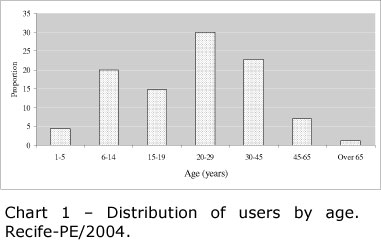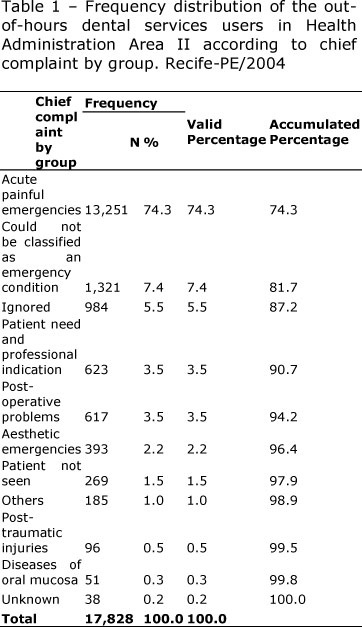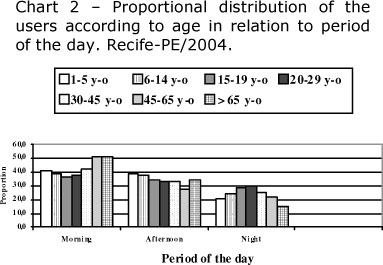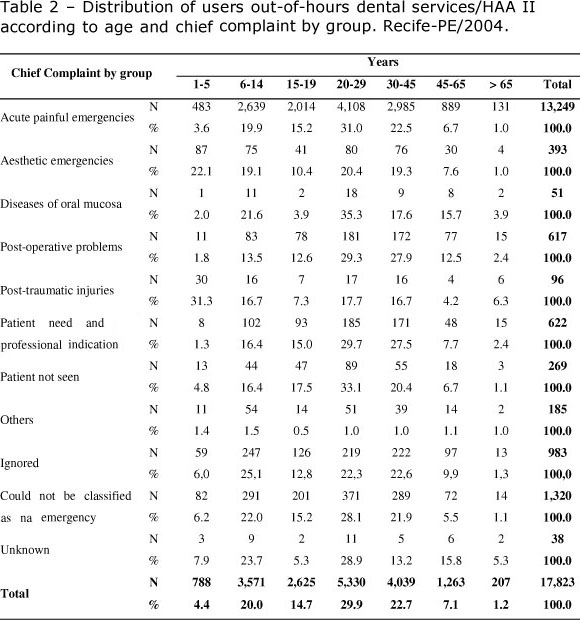Serviços Personalizados
Artigo
Links relacionados
Compartilhar
IJD. International Journal of Dentistry
versão On-line ISSN 1806-146X
IJD, Int. j. dent. vol.9 no.3 Recife Jul./Set. 2010
ORIGINAL ARTICLE ARTIGO ORIGINAL
Evaluation of out-of-hours dental service, Recife, Brasil
Avaliação do serviço odontológico de urgência, Recife, Brasil
Nilcema FigueiredoI; Leonardo CarnutII; Paulo Sávio Angeiras de GoesIII
IPhD of Dental Public Health, Pernambuco School of Dentistry, University of Pernambuco, Recife, Brazil Senior Lecture Department of Social Medicine, Federal University of Pernambuco, Recife, Brazil
IIPostgraduate Student, Dental Public Heath, Specialization Course, Pernambuco School of Dentistry, University of Pernambuco, Brazil
IIIPhD of Epidemiology and Public Heath, University College London - United Kingdom
ABSTRACT
To evaluate the establishment of an out-of-hours dental service in Recife. This was a quantitative study using a sec o ndary data setting design. Data were collected using clinical and sociodemographic information from the entire population requiring an out-of-hours dental service in Recife - PE - Brazl. The time frame used in the analyses was June 2003 to September 2004. The data analysis was divided into a descriptive and an analytical phase, using the chisquare test, with a 5% level of significance. The results showed that 17,878 users requested the service with an average of 1,188.5 users/m o nth. The mean age of the po pulatio n was 24.7 years (24.5 -24.9, 95°% CI). The main reaso n fo r users requesting the service was acute painful emergencies (74.3%). Only 7.4°% did not have their complaints classified as an emergency. The highest demand for the service was on Tuesdays (p < 0.05). Post-traumatic injures were more frequent in males (61.5°%) (p < 0.05), even though all other complaints showed a predominance of females. 1 to 5-year - olds had a high frequency of dental trauma (22%) and post-traumatic injuries (31%) (p < 0.05). There is a considerable demand for an out-of-hours dental service in Heath Administration Area II and it is very important in providing support at all levels of dental care.
Key words: Toothache; Dental heath services; Comprehensive dental care; Emergency.
RESUMO
Avaliar o serviço odontológico de urgência municipal da cidade do Recife. Este estudo utilizou a metodologia quantitativa com uso de dados secundários. Foram coletados informações relacionadas as condições clínicas e sociodemográficas da população que acessou o serviço odontológico de urgência, Recife - PE - Brasil. O período analisado foi de Junho de 2003 a setembro de 2004. A análise dos dados foi dividida em duas fases: uma descritiva e outra analítica, usando o tese de quiquadrado com nível de significância de 5%. Os resultados mostraram que 17.878 usuários demandaram ao serviço com uma média de 1.188,5 usuários/mês. A idade média da população atendida foi de 24,7 anos (24.5 - 24.9, 95% IC). A queixa principal mais frequentemente relatada pelos usuários que buscaram o serviço foram as urgências agudas dolorosas (74,3%). Somente 7,4% das queixas principais não puderam ser classificadas como um caso de urgência. A maioria dos usuários procuraram o serviço nas terças-feiras (p < 0.05). As feridas pós-traumáticas foram mais frequentes no sexo masculino (61,5%) (p < 0.05), enquanto que todas outras queixas principais predominavam no sexo feminino. Crianças de 1-5 anos tiveram alta frequência de trauma dental (22%) e feridas pós-traumáticas (31%) (p < 0.05). Há uma demanda considerável para o serviço odontológico de urgência do Distrito Sanitário II e este é muito importante no suporte a todos os níveis de atenção à saúde bucal.
Palavras-chave: Odontalgia; Serviços de saúde bucal; Assistência odontológica integral; Emergência
INTRODUCTION
The prevalence and severity of dental cares are declining in 12-year-old children. This fact has been demonstrated in the developed world1, in developing countries, including Brazil2 and, in particular Recife3, in the 1980s and 90's. However this decline has not been uniform in all social strata. Studies have shown that those who are at the bottom of the socioeconomic scale have the worst dental health. One explanation for this phenomenon has been the lack of access to and utilization of dental care services4,5.
In addition, the most common consequence of untreated dental caries is dental pain, which has a substantial impact on the sufferer's quality of life. This is due to its high prevalence and the resulting demand for public services, its impact on quality of life, mainly related to pain, discomfort, social and functional limitation adversely affecting the population's quality of life6,7.
In this context, it is necessary to increase coverage of dental services 1, especially in poor areas where most diseases are concentrated. A dental service must focus on primary health care, which should be responsible for most dental health actions and include out-of-hours dental services8.
In Brazil, public heath policy has shown recent advances, with great efforts being made to implement the Family Health Programme and the new National Oral Health Policy9. The main focus of the new policy is the steady increase in dental care coverage. This programme is based on the principles of primary health care and health promotion. However, it was not designed to provide out-of-hours dental services.
Out-of-hours dental services have been investigated in a number of studies with the aim of examining their impact on the general dental services system10,11. The ideal dental heath service system should have a well-organized primary care network with an established referral system for secondary and tertiary care that includes out-of-hours dental services and maxillofacial surgery emergencies. These should increase the effectiveness and efficacy of the system12-14. The out-of-hours dental services should function full time, including nights, weekends and holidays15, particularly for the relief of dental pain, which has been described as the users chief complaint16,17.
Thus, the aim of the present study was to investigate the role of the out-of-hours dental services in Recife, the distribution of users according to socio-demographic variable and chief complaint and to evaluate whether there are seasonal variations.
MATERIALS AND METHOD
The research was carried out in 2004, in Health Administration Area II (HAA II), Recife City, Pernambuco, Brazil. This Health Administration Area has a territory corresponding to 6.51% of the total area of the city. It has a population of 217,748, representing 14.48% of the city's entire population. An out-of-hours dental clinic in Recife was first established in an area with an index of human development of around 0.79, as in HAA II.
Secondary data were used from the clinical records of all the users of the out-of-hours dental service in the period July 2003 to September 2004. The data were obtained from 17,828 clinical records. Collected data attempted the variable as follow: age, gender, month, day of the week, period of the day in which the user received dental treatment from the service and chief complaint reported by the user.
Chief complains reported by users were classified by clustering groups of complain as suggested by Tortamano et al.18 and Figueiredo19, this classification took into account the nature of lesion. If it was pain related urg ency; such as toothache, non treated dental carie, periodontal disease, gingivitis, oral facial pain complains were classified as acute painful urg encies; Also were considered self-perception treatment need from patient or other professional referral; complains were considered as postoperative problems when was reported hemorrhage, alveolitis or complications from dental extraction; Aesthetic emerg encies included dental trauma, prosthetics and filling fractures that compromise the aesthetic concern of patient; and posttraumatic injuries were assig ned when aesthetic concern of patient were not compromise; and diseases of oral mucosa that included those with lesions in the soft tissues. Also, cases were classified as "others" when they cannot be classified in any of the categ ories above, but have a diag nose from the dentist; and when patient look for treatment but was not seen by dental professional. Finally, it was considered unknown when patient do not have its complain in the form.
Data analysisconsisted of a descriptive phase and an analytical one. Descriptive analysis comprised frequency distribution, mean and standard deviation. To test for significant differences, the chi-square test was employed. Data was analyzed using the Statistical Package for Social Sciences (SPSS), version 10.0, for the descriptive and analytical phases. For all analysis the 5% level of significance was adopted.
RESULTS
The mean age of the population was 24.7 years (24.5 - 24.9, 95°% CI) and the age distribution can be seen in Chart 1. Regarding gender, 57.1% of the users were female and 42.9% male. Most of the sample came from the geographical area covered by the service (71.5°%).

The main reason for seeking the service was acute painful emergencies (74.3%). In only/ 7.4°% of the total were the complaints not classified as an emergency (Table 1). Among the acute painful emergencies dental pain is the most prevalent (60.6°%).

Analysis of the seasonal variations in the sample demonstrated that Tuesday was the day of the week with the highest demand (p < 0.05).
The results showed that 17,878 users sought the service during the study with an average of 1,188.5 userssmonth. The highest demand was in October 2003, with 1,633 patients seen (9.3%), and the lowest in February 2004 with 910 (5.1%). The service presents a mean of 39.6 users a day. Demand was hig hest in the morning (39.7%), followed by the afternoon (34.1%) and night (26.1%).
An association between gender and chief complaint showed that the female gender was predominant except in the case of post-traumatic injuries, which showed a male predominance of 61.5%% (p < 0.05).
A relationship was found between age and the period of the day for out-of-hours dental services. At morning, adults over 45 years were the majority. At afternoon, children until 14 year were more frequent, while teenagers (15-19 years) and adults (20-29 years) came more at night (Chart 2).

DISCUSSION
Several studies have shown the important role of out-of-hours dental services, available 24 hours per day, in increasing access to dental care11,13,20 particularly in view of the high frequency of dental pain, which has been reported as the chief complaint10.
One of the advantages offered by out-of-hours dental services reported by Watson et al.14 is that they provide access to people who are normally excluded from the official health services. Even in Brazil, where health care is offered to all, as a state responsibility, the present study showed that the majority of people treated by this service came from the same geographic area, which is a predominantly/ poor area of Recife. We can therefore, argue in favor of including these services as part of oral health care delivery. This could increase their efficacy and quality20,21.
The study also found that dental pain was the main reason for users seeking assistance from out-of-hours dental services. This finding has been reported by several studies8,13,22. In Brazil, this fact may be attributed to the conditions of oral health. The National Oral Health survey showed that dental cares and its consequences such as missing teeth and dental pain are the main oral health problems for Brazilian society23. However one finding from the present study that should be highlighted is the high proportion of people aged 6-14 years who were assisted by an out-of-hours dental service. One possible reason why people in this age group are highly frequent users of the out-of-hours dental services is the severe social exclusion, in relation to dental care, of a large segment of the Brazilian population, despite the fact that results of the National Oral Health Survey showed a decrease in dental cares from 1996 to 2003 in 12-year-olds23.
Another point highlighted by this study is the relation between chief complaint and age, especially, in 1 to 5-year-olds, who had had a higher frequency of aesthetic emergencies (22%), including dental trauma, and of post-traumatic injuries (31%). Several studies have demonstrated the importance of traumatic injuries in this group24-26. Post-traumatic injuries have proved to be common complaints in out-of-hours dental services16. The present study also demonstrated the importance of the service being organized and prepared to deal with lesions resulting from accidents, urban and domestic violence27.
The results of this study support the argument that the dental out-of-hour service is very important for the public dental care delivery system in Brazil. It can provide assistance and promote continuous access for the population requiring immediate attention to their dental problems.
CONCLUSION
There is a considerable demand for the dental out-of-hours service introduced in Health Administration Area II, Recife-PE, Brazil. It represents an important service within the structure of the oral health model and needs to be integrated into secondary care and the referral system in the oral health network.

REFERENCES
1. Thomas DW, Satterthwaite J, Absi EG, Shepherd JP. Trends in the referral and treatment of new patients at a free emergency dental clinic since 1989. Br Dent J 1997; 11-14. [ Links ]
2. Narvai PC, Frazão P, Roncalli AG, Antunes, JLF. Cárie dentária no Bras: declínio, polarização, iniqüidade e exclusão social. Rev Panam Salud Publica 2006; 19(6):385-393. [ Links ]
3. Soriano E, Sampaio P, Rodrigues CS. Tendências na experiência de cárie dentária em crianças de 12 anos de idade, residentes no Recife: dados referentes às décadas de 70 - 90. Revista Ação Coletiva 1998; 1(4):23-26. [ Links ]
4. Patussi MP, Marcenes W, Croucher R, Sheiham A. Social deprivation, income inequality, social cohesion and dental cares in Brazilian school children. Soc Sci Med 2001 3:915-25. [ Links ]
5. Watt RG, Sheiham A. Inequalities in oral health: a review of the evidence and reco mmendatio ns fo r action. Br Dent J 1999; 187:6-12. [ Links ]
6. Goes PSA, Sheiham A, Watt RG, Hardy R. The prevalence and seventy of dental pain in 14-15 year old Brazilian schoolchildren. Community Dent Health 2007; 24:217-24. [ Links ]
7. Lacerda JT, Simionato EM, Peres KG et al. Dor de origem dental como motivo de consulta odontológica em uma população adulta. Rev Saude Publica 2004; 38(3):453-458. [ Links ]
8. Scully C. The pattern of patient attendance for emergency care in a British dental teaching hospital. Community Dent Heath 1995; 12:151-154. [ Links ]
9. Costa NR, Pinto LF. Avaliação de programa de atenção à saúde: incentivo à oferta de atenção ambulatorial e a experiência da descentralização no Brasil. Cien Saude Colet 2002; 7(4):907-923. [ Links ]
10. Cohen LA, Manski RJ, Hooper FJ. Does the elimination of Medcaid reimbursement affect the frequency of department dental visits? J Am Dent Assoc 1996; 127: 605-609. [ Links ]
11. Dane JN, Hayden WJ, Soldanels AP. Retrospective study on emergency room dental patients retained in a hospital dental practice. Spec Care Dentist 1998; 102-105. [ Links ]
12. Key JD, Washington EC, Hulsey TC. Reduced emergency department utilization associated with school-based clinic enrollment. J Adolesc Health 2002; 46(3):95,98-102. [ Links ]
13. Sayers M, Rowland H, Djemal S. Experiences in a Dental Emergency Clinic. Eur J Prosthodont Restor Dent 2004; 12(1):5-8. [ Links ]
14. Watson ML, Trompeter KM, Lang P, Allen D, Mifsud J, McGowan JM. A community collaboration: the dental emergency assistance program. J Am Dent Assoc 1996; 127:1240-1246. [ Links ]
15. Dickinson TM, Guest PG. An audit of demand and provision of emergency dental treatment. Br Dent J 1996; 181:86-87. [ Links ]
16. Guerra ME. El pediatra frente a lo s traumatismos dentales. Arch Venez Pueric Pediatr 2000; 63(3):123-129. [ Links ]
17. Schwartz S. A one-year statistical analysis of dental emergencies in a pediatric hospital. J Can Dent Assoc 1994; 60:959-968. [ Links ]
18. Tortamano IP. et al. As Urgências odontológicas e o tratamento clínico e medicamentoso integrado. JBC 2004; v.8(43):78-85. [ Links ]
19. Figueiredo N. Urgência Odontológica: Um Passo na Consolidação da Atenção Básica em Saúde Bucal [dissertação]. Recife: Universidade de Pernambuco; 2004. [ Links ]
20. Anderson R, Thomas DW. Tootache stories': a quality investigation of why and how people seek emergency dental care. Community Dent Heath 2003; 20:106-11. [ Links ]
21. Rehman KU. Emergency dental services: review of the Community Heath NHS Trust Service in Birmingham between 1997 and 2000. Prim Dent Care 2003; 10(3):93-6. [ Links ]
22. Agostini FG, Flaitz CM, Hicks MJ. Dental emergencies in a university-based pediatric dentistry postgraduate outpatient clinic: a retrospective study. ASCD J Dent Child 2001; 68(5-6)316-21, 300-1. [ Links ]
23. Brasil, Ministério da Saúde. Projeto SB Brasil 2003: condições de saúde bucal da população braseira 2002-2003: resultados principais. Ministério da Saúde, Secretaria de Atenção à Saúde. Departamento de Atenção Básica. - Brasília: Ministério da Saúde, 2004. [ Links ]
24. Gutierrez CA, Salazar VCR, Pirela de Manzano A, Manzano M. Traumatismos en dientes anterosuperiores e inferiores: prevalencia en preescolares y sus consecuencias en dentición primaria. Acta Odontol Venez 1999; 37(1):134-145. [ Links ]
25. Meira R, Barcelos R, Primo LG. Respostas do complexo dentino-pulpar aos traumatismos em dentes decíduos. J Bras Odontopediatr Odontol Bebê 2003; 6(29):50-55. [ Links ]
26. Roizen S, Urzúa S. Traumatismo dental en la infancia: del dentista al pediatra. Pediatr. día 1997; 13(4):224-8. [ Links ]
27. Silva OMP, Lebrão M. L. A organização do atendimento da odontologia hospitalar e da traumatologic buco-maxilo-facial no município de São Paulo. Rev Odontol UNESP 2001; 30(1):43-54. [ Links ]
 Correspondent author:
Correspondent author:
Nilcema Figueiredo
José Bonifácio Street, n.125, 1602, Madalena
Post Code: 50710-000, Recife - PE, Brasil
Tel: +55 (81) 9962-8460
Email: nilcema@uol.com.br
Recebido em 03/06/2010
Aceito em 15/08/2010
Senior Lecturer Department of Social Dentistry, School of Dentistry, University of Pernambuco , Recife, Brazl.













